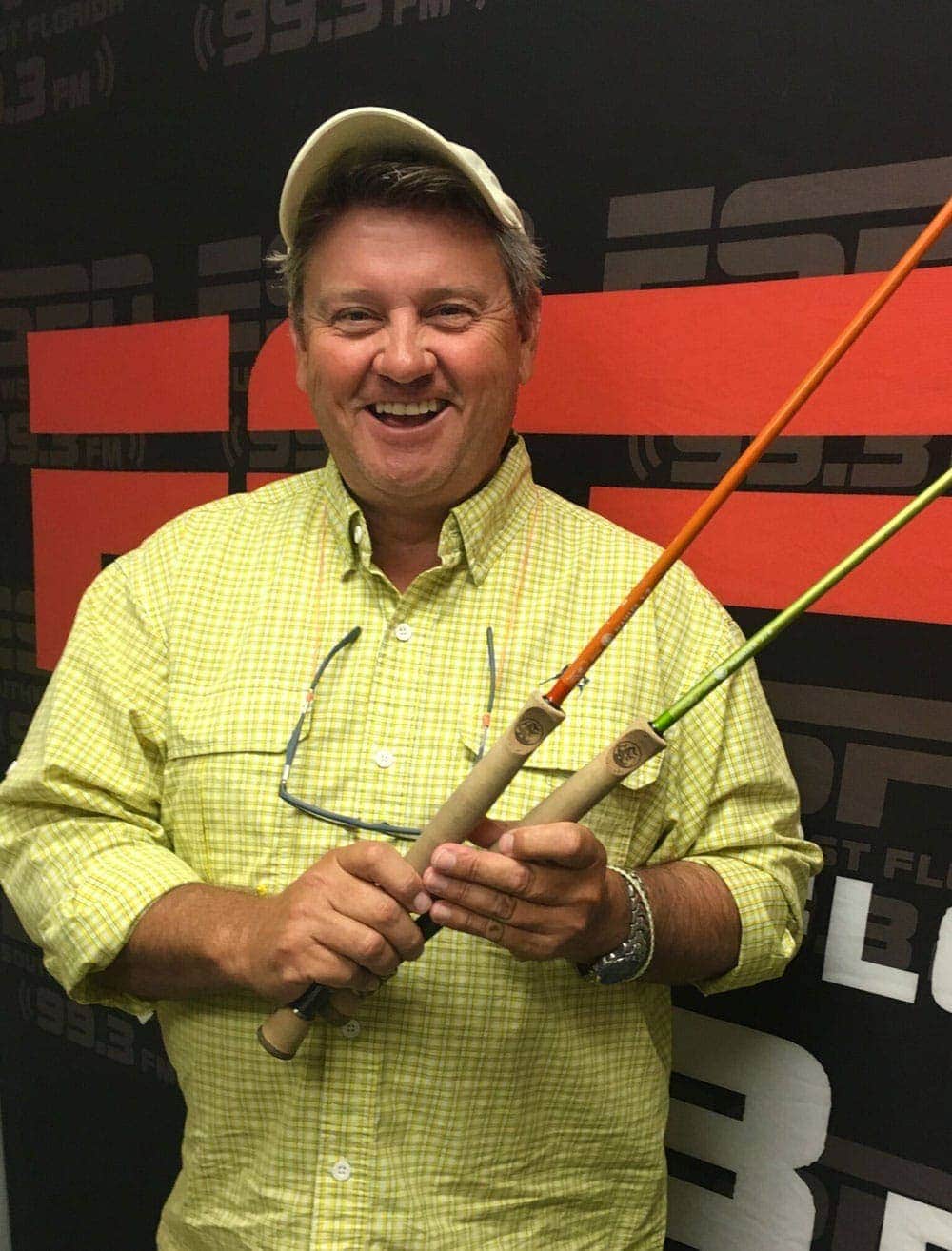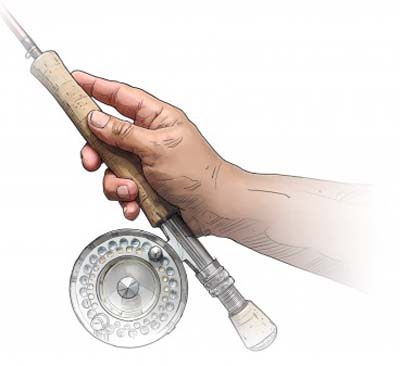
Joe Mahler’s casting method: Legend and angling friend to all he touched – Lefty Kreh [February 26, 1925 – March 14, 2018] with Joe Mahler at a 2013 Renzetti Fly Tying Fair. Photo credit The Fly Fisherman-Ross Purnell, editor.
If you can haul but still get flummoxed. Relax, Joe Mahler can fix that
Joe Mahler’s casting method is so much easier and puts accuracy on autopilot

Skip Clement, New Zealand.
By Skip Clement
In golf, football, and so many other sports, a better way to do something, improve performance, never seems to get acceptance immediately, even when it’s obvious. What do I mean? Take putting in golf, for example. From 2005 to 2010, pro golfers like Ernie Els began anchoring their putter to their chest, making the extra-long putter a hinge. Putting improved dramatically, and mediocre pro golfers started winning tournaments. Unfortunately, the new way of putting ran through the ranks like the flu and started to taint the hallowed game. Some chroniclers began calling the long, chest-anchored method of putting cheating.
Anchoring the putter to your body has been banned since around 2011/1012. And, BTW, many high-ranking players dependent on the hinged putting dropped out of sight on tournament scoreboards after being banned.
Fútbol [soccer] players from around the globe eventually took over American football’s extra point and field goals. Yet, initially, the obvious benefits of kicking a placed football like a soccer ball and not straight on faltered. After joining the AFL and NFL as one league, the fútbol style kick overtook the game.
As an aged NFL player [1961], I recall the cause of failure among foreign fútbol players in the NFL. They did not know ‘football.’ The issue was when the scrimmages were live, the behemoths were coming in full grunt and groan after the kicker – if you get my drift. However, that fear didn’t hold much water, and it faded when the AFL showed how it works better with the fútbol approach. No team in the NFL ever hired a straight-on kicker post-AFL/NFL merger.
If you are interested in improving your fly casting, try the Joe Mahler’s casting method
What happens ever so subtly to one of the most difficult athletic maneuvers between caster and fly rod equipment transactionally, double-haul fly casting, can become intuitively rooted. The feel is there where it wasn’t when casting conventionally on a plane.
It’s the difference between asking one’s fist to feel the fly line load versus the index finger, like tasting something with your lips rather than your tongue.
Place your index finger in line with the fly rod and make it your casting trigger. It will make casting more manageable, improve casting, particularly accuracy, and automatically eliminate wrist-hinge, the dread disease of the beginner and dedicated lousy caster. I and several friends who switched to Joe Mahler’s way claim improved distance, but that is not the point of Mahler’s technique.
Make the change – give it 20 minutes
There’s the barely measurable time needed to use the Mahler method successfully. Me, 10 minutes, but that was with Mahler at my side. The nuance of starting the rod tip low (water level) and coming up slowly, letting the rod load at a 45-degree angle, or more rise, took muscle memory time to get lost. Overcoming that parallel to the ground plane still creeps into my game sometimes. The forward cast doesn’t require relearning, but there are a few nuances learned to improve your performance on both distance and accuracy – read on.
There will always be deniers on Joe Mahler’s casting method
Deniers, of course, have a lot to say about why anything doesn’t work. For example, “Any fly rod 6-weight or above would permanently damage or even break a finger.” Last spring, that quote was from a pedigreed casting instructor at a Low Country Expo in South Carolina. Casting Joe Mahler’s Method did not prove harmful to anyone encouraged to give their 7- and 8-weights a try during the weekend.
I pointed out the Low Country Expo casting guru instructor was not an Orthopedic Hand Surgeon and was old-school, but not like me – just old like me.
I and some friends using Joe’s casting technique are comfortable with a Mahler casting technique even when using 10-weight rods on surf trips in South Florida. No problem.
That said, the Mahler casting technique is not good when there are ‘high’ obstructions behind you or when the wind is up while on a skiff deck trying to cast or while walking the flats bonefishing – the latter in both cases, a Belgian Cast or a low sidearm cast. With wind and casting from a skiff casting platform, you will know that a backhand cast is needed. That. of course does not mean that a wind issue is cause for abandoning Joe’s method. On the contrary, his method shines using the wind.

Mahler’s work appears in Fly Fisherman Magazine, Fly Life Magazine.com, Outdoor Life, and other publications. Joe is also the author and illustrator of “Essential Knots & Rigs for Trout” and “Essential Knots & Rigs for Salt Water” (Stackpole Books). As one of the nation’s leading fly casting instructors, Joe has been seen casting in national television commercials for Bass Pro Shops [Tracker and Mako Boats]. Joe has his line of rods built to spec by Reilly Rod Crafters – 5/6 and 7/8 – priced mid-range and perform top shelf.
Is it time for a grip switch?
By Joe Mahler [edited]
When the subject of grip comes up, and I express that I prefer the Index on top, the response is usually something like, “I can see using that for little short casts,” followed by a schoolmarm-like finger-pointing motion. But you might be surprised that when done properly, the Index on top grip offers the same power with less effort expended by the caster than the Thumb on top or the V-grip. The Thumb on top is the most popular grip used today, so that I will use it for comparison in this article.
The index finger on top is a cornerstone of my casting style. I use it when fishing because it is efficient. I use it in teaching because it makes my job easier and accelerates learning. It makes sense to me. As I see it, there are four primary reasons for choosing this grip, and here they are in order of importance.

Index on top. Illustration by Joe Mahler. We are re-posting Joe Mahler’s Sage blog piece, including his illustrations, with permission.
Leverage
As you know, the rod is a lever. Think of the hand as the lever that works the lever. Comparing the two grips, you will notice that the index finger extends considerably further up the cork than the Thumb. Simply put, the longer the lever, the less effort is required to operate it. I have been told that the Thumb is stronger than the index finger, and I don’t doubt it. But with the added leverage of the index finger, strength is no longer the issue. Applying the power with the fingertip is the key to getting the most from this grip. People are often surprised to find that I use this grip when using 10- or 12-weight rods, but there is no reason to change grip with equipment, and the added ease of casting is especially noticeable with heavier rods.
The Stop
The back cast is the foundation of the fly cast. If the back cast doesn’t straighten behind the caster, problems occur. Usually, the cause isn’t a lack of power but rather a failure to stop the rod firmly without allowing the rod tip to travel too far back. If you were to form an imaginary pistol with your casting hand and raise it so your finger points skyward, you’d notice that the Thumb is pointing back in a horizontal position. The Index on top provides a naturally correct stopping point for the back cast. It is challenging to go too far back using this grip.

Notice how down on the reel seat the grip is. It will amaze you how a few inches down into the handle improves things for you. Joe Mahler lives and teaches fly casting in the Sanibel / Fort Myers, Florida area – contact him here . . .
Attitude
In the Joe Mahler’s casting method the most significant difference in the two grips is the attitude or position of the hand, wrist, and forearm during the cast. With the Thumb on top, the hand and arm are raised and lowered like driving a hammer or chop with a hatchet.
When the index finger is placed on top, the hand, wrist, and forearm flatten – as if to push a door open. This motion encourages the caster to continue the stroke forward, stopping the hand at eye level rather than driving it downward.
Joe Mahler’s casting method Grip
It is easier to be more accurate with a rifle than a pistol because hitting a target with the Index on top is easier. I favor a more vertical cast than many and find that when I point the end of my Index finger (not the rod tip) at the target, I get a more accurate cast than with the shorter Thumb. An unwanted curve in the layout – especially at longer distances – can often be eliminated instantly simply by switching to the Index on top grip, as straight tracking seems easier to achieve.
In addition to the above reasons for choosing the Index on top, I will offer one more subtle point. As you sit reading this article, reach over and feel the surface of the table, desk, or chair. I guess that you used your fingertips – not your Thumb. As humans, we are conditioned to feel with our fingertips, and I always encourage students to cast with a loose grip relying on feel. One exercise I use frequently is having the students close their eyes and cast. In most instances, there is no difference between the eyes open and closed cast. I believe that the feeling in the index finger is keener and sends a sharper signal.

This is an illustration by Joe Mahler showing the proper finger grip R.
Joe Mahler’s casting method: Try it for yourself
Joe Mahler’s casting method quick tip for the Index on-top grip. Start by loosely gripping the rod slightly closer toward the butt than usual – I like to place the heel of my hand on the reel seat itself. Pretend that there is a button precisely at the point where the tip of the index finger contacts the cork. Ensure that the fingertip is the only part of the finger that touches the cork. Make your pick-up by placing the rod tip low and applying pressure with the inside of the middle finger to make the back cast, stopping the rod firmly with the Index. Now, smoothly move the rod forward in a straight line, and in the middle of the stroke, push that imaginary button with your fingertip and let off. You will find that push’s power is sufficient to unroll the fly line and straighten the leader.


